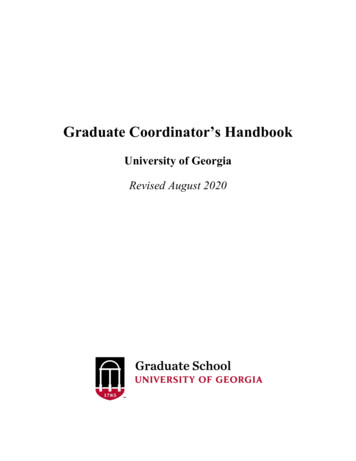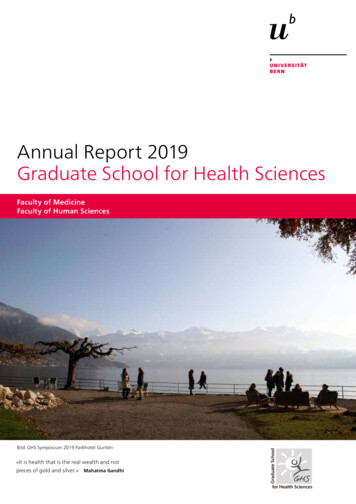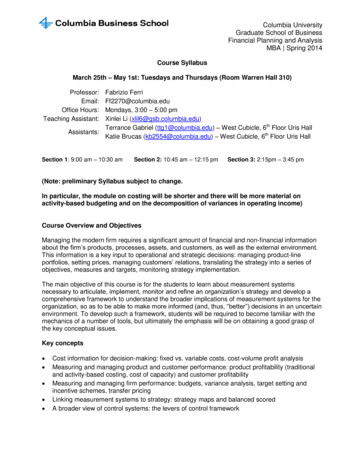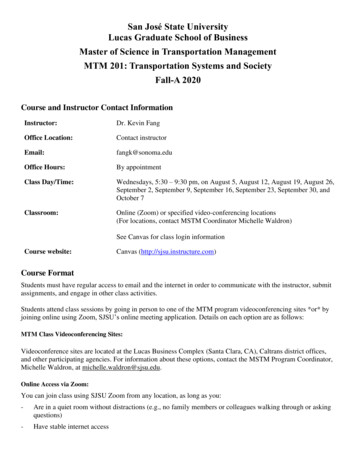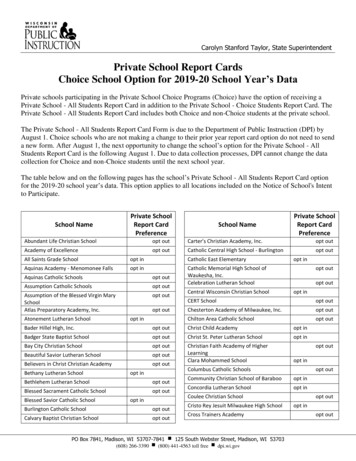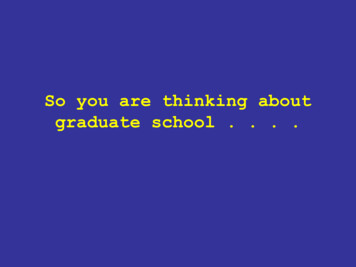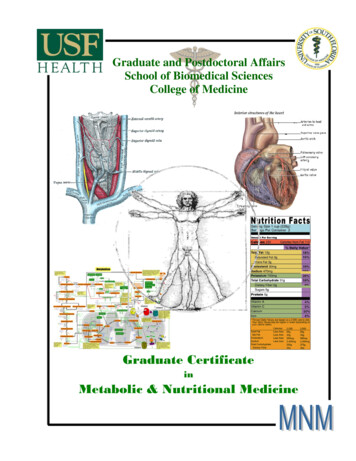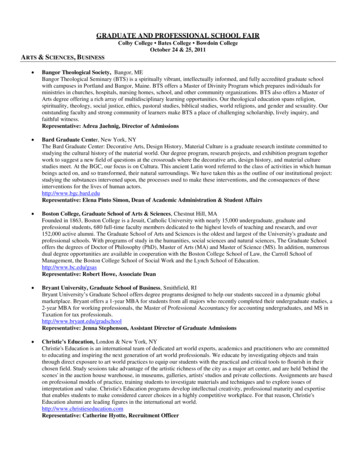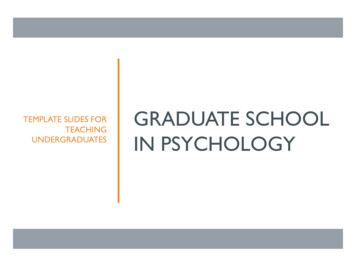
Transcription
Graduate School ReportApplications, Acceptance Rates, and EnrollmentDiscover what’s next. It’s the Washington Way. 2
Table of ContentsIntroduction . . . . . . . . . . . . . . . . . . . . . . . . . . . . . . . . . . . . . . . . . . . . . . . . . . . . . . . . . . . . . . . . . . . . . . . . . . . . . . . . . . 4Executive Summary . . . . . . . . . . . . . . . . . . . . . . . . . . . . . . . . . . . . . . . . . . . . . . . . . . . . . . . . . . . . . . . . . . . . . . . . . . . . . 6Applications / Demand . . . . . . . . . . . . . . . . . . . . . . . . . . . . . . . . . . . . . . . . . . . . . . . . . . . . . . . . . . . . . . . . . . . . . . . . . 8Applications / Demand . . . . . . . . . . . . . . . . . . . . . . . . . . . . . . . . . . . . . . . . . . . . . . . . . . . . . . . . . . . . . . . . . . . . . . . 10Trends in Applications / Demand . . . . . . . . . . . . . . . . . . . . . . . . . . . . . . . . . . . . . . . . . . . . . . . . . . . . . . . 11Master’s Degree Applications: UW Seattle . . . . . . . . . . . . . . . . . . . . . . . . . . . . . . . . . . . . . . . . . . . . . . . . 12Doctoral Degree Applications: UW Seattle . . . . . . . . . . . . . . . . . . . . . . . . . . . . . . . . . . . . . . . . . . . . . . . . . 13UW Bothell and UW Tacoma . . . . . . . . . . . . . . . . . . . . . . . . . . . . . . . . . . . . . . . . . . . . . . . . . . . . . . . . . . . 14Professional Degree Applications - DDS, JD, MD and PharmD . . . . . . . . . . . . . . . . . . . . . . . . . . . . . . . . . . 152010 Applications . . . . . . . . . . . . . . . . . . . . . . . . . . . . . . . . . . . . . . . . . . . . . . . . . . . . . . . . . . . . . . . . . . . . . . . . . . . . 16Trends in Applications, 2010 . . . . . . . . . . . . . . . . . . . . . . . . . . . . . . . . . . . . . . . . . . . . . . . . . . . . . . . . . . 17Who Is Applying: Previous Schools . . . . . . . . . . . . . . . . . . . . . . . . . . . . . . . . . . . . . . . . . . . . . . . . . . . . . . . . . . . . . 18Acceptance Rates and Yield . . . . . . . . . . . . . . . . . . . . . . . . . . . . . . . . . . . . . . . . . . . . . . . . . . . . . . . . . . . . . . . . . . . 19Acceptance Rates by College . . . . . . . . . . . . . . . . . . . . . . . . . . . . . . . . . . . . . . . . . . . . . . . . . . . . . . . . . . 21UW Bothell and UW Tacoma . . . . . . . . . . . . . . . . . . . . . . . . . . . . . . . . . . . . . . . . . . . . . . . . . . . . . . . . . . . 23Yield . . . . . . . . . . . . . . . . . . . . . . . . . . . . . . . . . . . . . . . . . . . . . . . . . . . . . . . . . . . . . . . . . . . . . . . . . . . . . . . . . . . . . . . . 24Yield Rates by College . . . . . . . . . . . . . . . . . . . . . . . . . . . . . . . . . . . . . . . . . . . . . . . . . . . . . . . . . . . . . . . 25UW Bothell and UW Tacoma . . . . . . . . . . . . . . . . . . . . . . . . . . . . . . . . . . . . . . . . . . . . . . . . . . . . . . . . . . . 27Enrollment . . . . . . . . . . . . . . . . . . . . . . . . . . . . . . . . . . . . . . . . . . . . . . . . . . . . . . . . . . . . . . . . . . . . . . . . . . . . . . . . . . . 28Trends . . . . . . . . . . . . . . . . . . . . . . . . . . . . . . . . . . . . . . . . . . . . . . . . . . . . . . . . . . . . . . . . . . . . . . . . . . . . . . . . . . . . . . 29UW Seattle, Autumn Quarter Enrollment Growth by Level and College . . . . . . . . . . . . . . . . . . . . . . . . . . . 30Trends: UW Bothell and UW Tacoma . . . . . . . . . . . . . . . . . . . . . . . . . . . . . . . . . . . . . . . . . . . . . . . . . . . . . 32Data Sources and Methods . . . . . . . . . . . . . . . . . . . . . . . . . . . . . . . . . . . . . . . . . . . . . . . . . . . . . . . . . . . . . . . . . . . 33- 3 -
IntroductionWhat are the key issues and definitions?DemandHow many people apply for graduate programs at theUniversity of Washington? What do they want to study?We define demand as applications to the UW.Acceptance RatesHow rigorous are we? A 25 percent acceptance ratemeans that a unit accepts 25 percent of all applicantsand rejects 75 percent.Yield-How successful are we in enrolling the people we admit?A 50 percent "yield" means that half of the students weadmit actually attend the UW; half do not.Enrollment-Which colleges and schools are growing? Which are not?
Graduate and Professional Student EnrollmentAerospace companies need more engineers. Health care needs more nurses and therapists. Computersoftware companies are recruiting developers from other countries because the United States isn’tproducing enough highly-skilled workers. Bioengineering faces a 72 percent job growth rate over the next10 years, according to the U.S. Bureau of Labor Statistics.Teachers and principals are eyeing retirement, which will leave shortages in classrooms. Within the nextfive years, the majority of UW faculty will be older than 62. Who will take their places? Who are the nextgeneration of thinkers who will solve our problems and create new fields?The lack of well-educated, innovative workers threatens our nation’s productivity – our competitive edgein the global economy. Add to that an increased need for those providing social services and education –things our community needs to survive and thrive. The UW plays an important role in this. Which graduateprograms we grow and how many students we admit will determine the supply of workers who fuel oureconomy and make our communities better places to live.To plan for our future, we need first to consider carefully how many people are applying to the UW, whatthey want to study, how many we admit and how many actually enroll. The information in this reportwill help us balance the demands of the marketplace and recovering economy with the aspirations of ourstudents while fulfilling the University’s mission of preserving, advancing and disseminating knowledge.- 5 -
Executive Summary
Demand for our graduate and professional degrees is growing rapidly; we’ve had an increase of 10 percentin enrollment since 2005. This report examines the demand for UW graduate and professional programs,how selective we are in admitting students, how successful we are in enrolling those we admit and whichcolleges and schools are growing and which ones are not.ApplicationsDemand for advanced training is growing in a wide variety of fields to meet the needs of industry, nonprofit organizations, government agencies, and the community at large.ff As measured by applications for graduate study, demand has risen 38 percent since 2001 and21 percent since 2005.ff Applications hit new highs for 2010, running about 14 percent ahead of last year at this time.ff Demand has been consistently high, year after year in Pharmacy, Public Affairs, Public Health, andSocial Work. UW Bothell and UW Tacoma also have seen substantial growth in applications.ff Several large UW Seattle programs — notably Business, Engineering, and the Sciences Division of Arts &Sciences — continue to see substantive increases in applications.ff The creation of new master’s programs has helped boost demand. Since 2005, units have instituted28 new programs or tracks, accounting for 2,375 additional applications.*ff Demand is high for several master’s degrees, specifically those in Pharmacy, Medicine, Public Affairs,Engineering, Public Health and Social Work.SelectivityThe UW remains a highly selective institution. Master’s acceptance rates run at 49 percent, and doctoralacceptance rates at 22 percent.YieldYield, measured by the percentage of applicants admitted who actually enroll, is 63 percent for master’sdegree programs and 48 percent for doctoral degree programs.EnrollmentColleges and programs that have seen significant growth include Engineering, Law, Nursing, Informationand Public Affairs.* For data on each college, school, and program, refer to the appendix: t2-appendix.pdf.- 7 -
Applications / Demand
This report focus extensively on UW application trends since 2005. Some of the key questions guiding usinclude:ff How many applications are there?ff What’s the overall trend? Because we want to get a sense of trends, we focus on average annualincreases from 2005 to 2009; applications generally rise and fall from year to year, so an averageannual increase provides a good measure of whether a trend exists or not.ff What’s the application trend for each college or school? Is there potential for growth in some areas?ff What are the growth trends in applications for doctoral and master’s programs at UW Seattle? Insome units, demand is higher for master’s degrees than for doctoral degrees; in other areas, doctoralprograms have seen growth in demand.ff What are the growth trends in applications at UW Bothell and UW Tacoma? Although these graduateprograms are not large, they are witnessing substantial growth. Unmet demand at UW Seattle may alsoindicate areas for future growth for UW Bothell or UW Tacoma.ff What’s happening this year in applications? Applications have not yet closed for autumn admission,but the number of applications is higher than last year — by about 14 percent compared to last year atthis time. Some programs are seeing substantial growth in demand.ff Where do our applicants come from? What is the pipeline to graduate and professional study at theUW? Do certain schools, or countries, provide substantial numbers of applicants?Any analysis of applications – demand – comes with several caveats. These include:ff Many applicants may not be qualified for admission, so the number of applicants alone should notguide decisions about growth or lack of growth.ff Many prospective graduate students apply to five schools or more; while the UW may be the top choicefor many of these applicants, it is probably not the top choice for all of them. So applications, bythemselves, are a somewhat imperfect measure of demand.ff Our analysis focuses primarily on the applications for admission in 2005 through 2009. Admissionsfor 2010 have not yet closed, so we do not have full data on this year. We will report again, in autumn2010, on these trends.For data on each college, school, and program, refer to the appendix: t2-appendix.pdf.- 9 -
Applications / DemandApplications/Demand for Graduate and Professional Educationff Applications rose 21 percent between 2005 and 2009.ff Applications for 2010 (as of July 13, 2010) have risen 14 percent over 2009.2009 ApplicationsFIGURE 1UW Applicants 2009*ff 29,213 applicants for all UW graduate and professionalprograms at all three campuses.ff UW Seattle: 20,192 applicants for 146 master’s programsand 87 doctoral programs – a 21 percent increase over2005 (10,942 master's applications, 9,250 doctoralapplications).ff UW Seattle: 8,168 applicants for four professional degrees Dentistry, Law, Medicine and Pharmacy.Masterʼs56%ff UW Bothell: 374 applicants for five master’s programs –a 121 percent increase over 2005.Doctoral44%ff UW Tacoma: 479 applicants for six master’s programs –a 78 percent increase over 2005.FIGURE 2UW Applicants, Master’s and Doctoral*NUMBER OF ,2504,0002,00002005MasterʼsDoctoral* Figures include all three campuses (Seattle, Bothell and Tacoma).- 10 -2009
Trends in Applications / DemandDemand grew steadily from 2005 to 2009. This chart shows:ff Average annual growth of applications for each college (e.g., Public Affairs saw an average of about 15 percentincrease per year in applications, thus indicating a persistent growth in demand).ff Range: Numbers in parenthesis refer to change in number of applicants from 2005 to 2009 (e.g., Education had680 applications in 2005 and 916 in 2009).ff Declines: Some units report that declining application rates were offset by rising test scores among those whodid apply. For these, the applicant pool may be smaller – but stronger - than before.ff Graph does not include DDS, JD, MD, and PharmD. See page 15 for those figures.FIGURE 3Average Annual Application Growth by College, 2005-20090%A&S - Arts (814-780)2%A&S - Humanities (1,136-1,219)4%A&S - Sciences** (2,346-2,687)A&S - Social Sciences (1,813-1,588)-3%6%Built Environments (793-988)4%Business (1,445-1,666)Dentistry (265-195)-7%9%Education (680-916)5%Engineering (2,485-2,927)0%Environment* (745-730)7%Information School (526-672)3%Interdisciplinary Graduate School Programs*** (809-910)7%Law (269-350)11%Medicine (1,167-1,742)6%Nursing (335-342)24%Pharmacy (82-175)15%Public Affairs (379-645)13%Public Health (908-1,456)9%Social Work (545-747)5%Average Annual-20%-15%-10%-5%0%5%10%15%20%PERCENT GROWTH*The College of the Environment has only existed since Autumn 2009. However, the six departments that comprise the college existed longer.The data for those departments have been combined and presented as the College of the Environment throughout this report.** Atmospheric Sciences and Earth and Space Sciences moved from A&S-Sciences to the College of the Environment in 2009.***A list of programs that are categorized as Interdisciplinary Graduate School Programs is at the end of this report.- 11 -25%
Master’s Degree Applications: UW SeattleDemand varies by degree program. This chart shows growth in applications for master’s degrees.ff Percentages (e.g., Engineering, 13 percent) show the average annual growth in applications. Across the five years,2005-2009, Engineering saw an average of 13 percent increase in applications each year.ff To provide context, we also report the range of change between 2005 and 2009 (e.g., Engineering had 936applications for its master’s programs in 2005 and 1,520 in 2009).ff Declines in applications are most pronounced in units that were in a state of transition (e.g., notably Arts &Sciences-Sciences). During this period, two departments moved (from Arts & Sciences-Sciences) into the newCollege of the Environment.FIGURE 4Average Annual Application Growth, 2005-2009, Master’s-1%A&S - Arts (660-611)-5%A&S - Humanities (846-697)-2%A&S - Sciences** (489-413)A&S - Social Sciences (723-531)-7%6%Built Environments (781-953)3%Business (1,095-1,216)Dentistry (254-184)-7%8%Education (501-672)13%Engineering (936-1,520)-5%Environment* (477-388)7%Information School (472-604)10%Interdisciplinary Graduate School Programs (101-139)7%Law (263-341)41%Medicine (131-440)-10%Nursing (301-107)-8%Pharmacy*** (36-33)13%Public Affairs (379-608)14%Public Health (657-1,080)9%Social Work (499-687)5%Average Annual-40%-30%-20%-10%0%10%20%30%40%PERCENT GROWTH*The College of the Environment has only existed since Autumn 2009. However, the six departments that comprise the college existed longer.The data for those departments have been combined and presented as the College of the Environment throughout this report.** Atmospheric Sciences and Earth and Space Sciences, moved from A&S-Sciences to the College of the Environment in 2009.*** The Pharmacy master’s (fee-based) program began in 2008. Application growth is for the 2008-09 and 2009-10 academic years.- 12 -50%
Doctoral Degree Applications: UW SeattleDemand varies by degree program. This chart shows growth in applications for doctoral degrees.ff Percentages (e.g., Public Health, 11 percent) show the average annual growth in applications. Across the fiveyears, 2005-2009, Public Health saw an average of 11 percent increase in applications each year.ff To provide context, we also report the range of change between 2005 and 2009 (e.g., Public Health had 251applications for its doctoral programs in 2005 and 376 in 2009).ff The Public Affairs doctoral program was new during this period and witnessed some declines, but its 2010applications are up significantly.ff Graph does not include DDS, JD, MD, and PharmD. See page 15 for those figures.FIGURE 5Average Annual Application Growth, 2005-2009, DoctoralA&S - Arts (154-169)3%17%A&S - Humanities (290-522)5%A&S - Sciences** (1,857-2,274)-1%A&S - Social Sciences (1,090-1,057)37%Built Environments (12-35)7%Business (350-450)Dentistry (11-11)1%10%Education (179-244)Engineering (1,549-1,407)0%Environment* (268-342)7%Information School (54-68)7%2%Interdisciplinary Graduate School Programs (708-771)99%Law (6-9)6%Medicine (1,036-1,302)67%Nursing (34-235)16%Pharmacy (82-142)-3%Public Affairs*** (47-37)11%Public Health (251-376)15%Social Work (46-60)4%Average Annual-60%-40%-20%0%20%40%60%80%PERCENT GROWTH*The College of the Environment has only existed since Autumn 2009. However, the six departments that comprise the college existed longer.The data for those departments have been combined and presented as the College of the Environment throughout this report.** Atmospheric Sciences and Earth and Space Sciences, moved from A&S-Sciences to the College of the Environment.***The Public Affairs doctoral program began in 2006.- 13 -100%
UW Bothell and UW TacomaBoth UW Bothell and UW Tacoma were founded in 1990. Each instituted master’s programs in 1992 and has addedadditional programs since then. Figures below are for master's programs only.ff Percentages show the average annual growth in applications (e.g., UW Bothell’s Interdisciplinary Arts andSciences Program has seen a 24 percent average annual increase in applications; UW Tacoma’s InterdisciplinaryArts and Sciences Program has seen a 14 percent average annual increase in applications).ff To provide context, we also report the range of change between 2005 and 2009 (e.g., UW Bothell Education had31 applicants in 2005 and 109 in 2009).FIGURE 6UW Bothell, Average Annual Application Growth, 2005-2009Business (72-126)19%Computing and Software Systems* (0-40)0%Education (31-109)38%Interdisciplinary Arts and Sciences (37-69)24%Nursing (29-30)12%Average ERCENT GROWTHFIGURE 7UW Tacoma, Average Annual Application Growth, 2005-2009-9%Business (48-30)Education (54-168)45%Institute of Technology (25-46)27%Interdisciplinary Arts and Sciences (30-29)14%Nursing (45-50)3%Social Work (65-156)32%Average Annual-25%-20%-15%-10%-5%0%18%5%10%15%PERCENT GROWTH*Computing and Software Systems program was founded in 2009.- 14 -20%25%30%35%40%45%50%
Professional Degree Applications - DDS, JD, MD and PharmDPercentages show the average annual growth in applications.For example:ff The Doctor of Dental Surgery program has seen a 4 percent average annual increase in applications.ff To provide context, we also report the range of change between 2005
ff UW Seattle: 20,192 applicants for 146 master’s programs and 87 doctoral programs – a 21 percent increase over 2005 (10,942 master's applications, 9,250 doctoral applications) . ff UW Seattle: 8,168 ap
